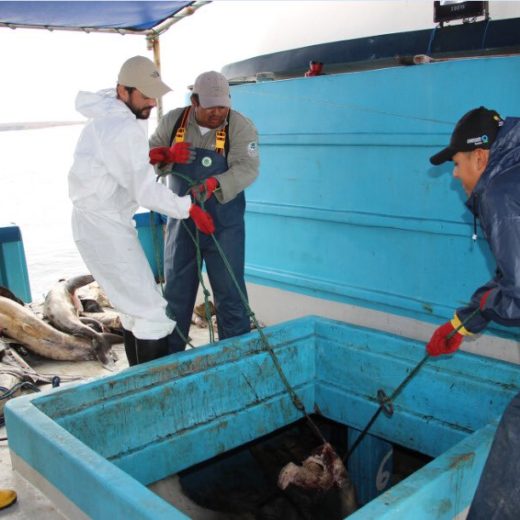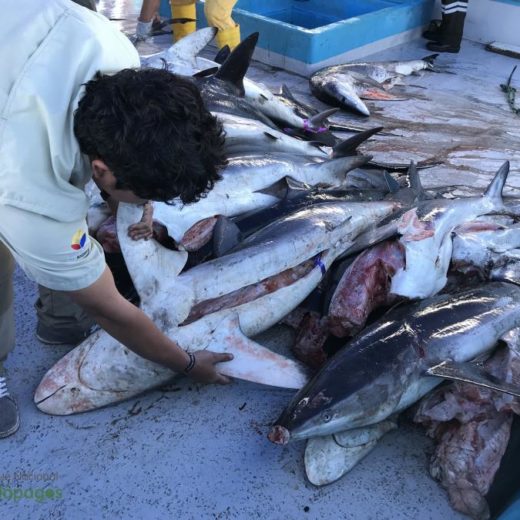
In a significant move to save one of the world’s most-treasured marine animals, Peru has approved strong regulations to protect the giant oceanic manta ray, a species particularly vulnerable to fishing activity.
Manta ray populations are under serious threat worldwide from fisheries targeting mantas for their gills and meat, and from accidental entanglement in nets and fishing line. Last year, a giant oceanic manta caught in a gill net by Peruvian fishermen made international headlines, sparking calls to strengthen protections for mantas, whose gill plates are often sold in some Asian markets for use in a “health tonic.”
Peru has the world’s largest-known population of giant oceanic manta rays, according to research by Manta Trust. On December 31, the country’s Ministry of
Production passed a resolution prohibiting manta fishing and mandating that any mantas caught as bycatch be immediately released back into the ocean, among other key requirements. Text of the resolution was recently published in the official daily newspaper El Peruano.“My team and I are extremely proud to have generated legal action for the protection of giant oceanic manta rays in Peru through this Ministerial Resolution. We thus highlight our commitment to promote positive change within our fisheries sector. Our ultimate goal is to achieve sustainable fisheries and sustainable consumption in benefit of future generations,” said Jesús Eloy Barrientos Ruiz, Director of Supervision and Fiscalization of the Ministry of Production.
The resolution comes after years of advocacy work by Planeta Océano, WildAid and The Manta Trust to shore up protection for mantas in Peru. Working closely with coastal fishing communities, the three nonprofit organizations have partnered in research on how mantas are affected by local fisheries — both directly and as bycatch — as well as how to reduce manta mortality.
Building on work in Indonesia to protect mantas in territorial waters and promote manta tourism, these organizations are working to introduce manta tourism to the region, which would provide a valuable alternative livelihood to local communities as well as an economic incentive to protecting this species.
“Manta rays reproduce very, very slowly, and can be impacted by even limited fishing. Peru’s new level of protection is vital to their survival and paves the way for the development of a sustainable manta ray tourism industry, which globally generates $140 million every year,” said WildAid CEO Peter Knights.
Peru joins a dozen countries with manta protection laws, including its northern neighbor, Ecuador. Peru’s new protection measure is crucial for the region, as mantas migrate between Peruvian and Ecuadorian waters.
Josh Stewart, Associate Director of The Manta Trust, said: “The Peruvian government has taken commendable and critical steps to protect this unique population, and with proper enforcement it will now be safe from exploitation on both sides of the border.”
However, Peru’s new resolution does not protect mobula rays, a group of species similar in appearance to manta rays that belong to the same taxonomic family. WildAid and its partners call for comprehensive protections that address both manta and mobula ray conservation issues.
Additional goals for the collaborative project by WildAid, The Manta Trust and Planeta Océano include:
- Scientific research to learn more about the biology and behavior of this important population of manta rays and to identify critical habitat zones
- Education and outreach activities that will build awareness and support for manta conservation in the community
- Vocational training in hospitality and tourism to provide fishermen with a sustainable alternatives to consumptive fisheries for mantas
- Coordination with government officials to establish protected areas or prohibit or limit high risk gears in critical manta zones
Kerstin Forsberg, Director of Planeta Océano, said of the new resolution: “Legal protection for manta rays could not be adequately implemented if it were not for effective local community engagement. By empowering artisanal fishermen in manta ecotourism, we hope to elevate the profile of manta ray conservation in Peru, while providing alternate livelihoods to low-income communities.”
Wilmer Purizaca Ayala, an artisanal fisherman who lives in Peru’s Tumbes Region and works with Planeta Océano, said of the program: “It is very important to conserve manta rays, as they can create jobs for artisanal fishermen and the community. We know that manta rays are peaceful creatures.”
WildAid, The Manta Trust and Planeta Océano have received significant support for this work from the Disney Conservation Fund, the New England Aquarium, PADI Foundation and Vulcan Inc.
Stay in touch and get the latest WildAid updates.
SIGN UPAbout WildAid
WildAid is a non-profit organization with a mission to protect wildlife from illegal trade and other imminent threats. While most wildlife conservation groups focus on protecting animals from poaching, WildAid primarily works to reduce global consumption of wildlife products such as elephant ivory, rhino horn and shark fin soup. With an unrivaled portfolio of celebrity ambassadors and a global network of media partners, WildAid leverages more than $308 million in annual pro-bono media support with a simple message: When the Buying Stops, the Killing Can Too.
Journalists on deadline may email communications@wildaid.org


